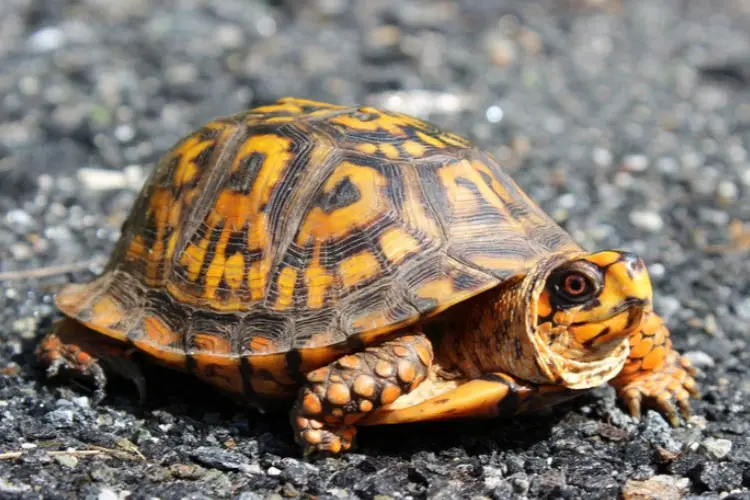Can Turtles Flip Themselves Over? Will It Die Being Upside Down?
If you’re worried about your turtle flipping itself over, this guide is for you. Most turtle owners wonder what happens if their turtle rolls over and if it can die while in this state, so we decided to search the web for answers.
So, can turtles flip themselves? Yes, most turtles can easily turn themselves over, but some may struggle to do it more than others. This is because different turtle species have varying shell shapes that affect how easily they can turn.
This guide will discuss more details about why turtles roll-off, how long they can survive on their back, and other important information you need to know.
Can turtles flip themselves over?
Contents
Most turtles will always flip themselves over if they’re upside down. But how easy it is to do so often depends on the species of turtles.
Your turtle may seem inflexible to you, and you may convince yourself that they can’t flip over. But the flip side is true; they’ll always try to flip themselves over.
A typical turtle will flip back over using its head; they simply stick its head out to one side to make its body shift slightly.
Next, they’ll push off against the ground using their feet, giving them enough lift to flip back onto their side.
Quite a show of ingenuity and craftiness for this little pet, right?
In the video below, you can easily see a turtle on its back flipping itself over effortlessly and quickly
However, flipping over isn’t easy for all turtles. While some (like the one in the above video seem to do it so effortlessly), others find it quite difficult to right themselves.
This explains why a turtle’s ability to flip themes over will depend on its species.
Also, some key factors influence the turtle’s ability to flip over, as discussed below:
- Shell shape: Species with a flat shell will have a harder time flipping over than the dome-shelled ones. This is because the latter shell shapes are only stable in one position and less stable when turned upside down than flat-shaped shells. This makes flipping over action will be less laborious for them. Shell shape evolution may have enabled turtles to self-right easily. At the same time, some species still struggle with this problem (maybe, they’re still evolving?)
- Limbs anatomy: The longer the neck and legs a turtle features, the higher its chances of flipping over are. Sea turtles have longer limbs, giving them a better chance of turning over than semi-aquatic and terrestrial species.
- Age: Regardless of the species, age will play a big role in their ability to turn over. Younger turtles can easily turn themselves over than older adults.
Why does my turtle keep flipping himself over?
If you notice that your turtle keeps flipping itself over, something might be wrong.
For instance, if your turtle shows this behavior and at the same time displays symptoms of an illness, take them to the vet for a professional examination.

Below are possible reasons your turtle keeps flipping themselves over:
Illness
A turtle suffering from respiratory infection, especially the one caused by vitamin A deficiency, might do lop-sided swimming, increasing its chances of flipping over.
Vitamin A deficiency changes your pet’s mucous membrane in their mouth, eyes, and respiratory tract. Early signs of infection to look out for include nasal discharge, loss of appetite, eyelid discharge and swelling, bubbling in the mouth, and ear swelling.
A turtle starts tilting to the side when swimming when the infection has already spread to its lungs. And they can no longer get good buoyancy in water.
Bottom line: If your turtle keeps flipping and shows symptoms of an infection, take them to a reptile vet ASAP!
Living conditions
Poor living conditions for your turtle could be another reason it keeps flipping.
Ensure that your turtle tank is correctly set up and is large enough (think aquarium length and water depth) to give your pet plenty of swimming room.
Be sure to maintain the water level deeper than your turtle’s width. This will enable your pet to easily right themselves after flipping over.
Your turtles are fighting
If you have your pets in one tank and one keeps flipping over, then there may be some clash.
If you have two or more males and females in the aquarium, the adult males might start fighting over the females during the breeding season. And the stronger male will easily flip the weaker one.

The male turtles may also harass your female turtle pets as they attempt to breed.
Mating
Yes, male turtles also tend to fall onto their backs after mating. During copulation in turtles, the male must mount the female for successful mating.
But this action is risky as the male can easily fall backward and end up laying upside down.
The male may stay in this position for prolonged periods, risking death. This can be even worse depending on the species of turtle in question.
Why does my baby turtle keep flipping over?
Your baby turtle probably keeps flipping over due to an underlying illness. Like adult turtles, young turtles can lose buoyancy if they have an infection.
Try health-checking your pet for any signs or symptoms of infection. If any, we advise you to take them to your vet as soon as possible for diagnosis and treatment before the illnesses can get worse.
Your baby turtle flipping itself may also have something to do with its aquarium conditions. Check if your aquarium has any decorations and plants that trap your little pet and tip it over.

Turtles are generally poor climbers; trying to climb anything uphill inside the tank can make them fall back on their shells.
Also, keep the aquarium water deeper than the width of your turtle. This is because your pet is more likely to fall on its back in shallow water. They’ll also have difficulty flipping themselves over in shallow water conditions.
What happens when a turtle gets flipped?
Many bad things can happen if a turtle gets flipped. This is because a turtle will not be able to move from place to place when in this position.
As such, they won’t get access to food, which increases the risk of starvation and death. Remember, turtles can’t survive for long without food under normal circumstances.
The turtle also won’t get access to water. This can be a hell of a problem as the turtle risks dehydration depending on the weather conditions. If they stay flipped for long hours under the hot sun, dehydration will surely catch up with them!

A turtle that’s upside down becomes highly vulnerable to predators. Even if they can hide inside their shell, they won’t be able to run away while in this state, and they may just become a free meal for the predator.
Besides the predator, small insects, e.g., an army of ants, may attack a turtle on its back. The turtle will be completely defenseless and helpless in this state.
The biggest problem that can happen to a turtle when flipped is its internal organs pressing on the lungs. Turtle lungs are typically positioned at the top of their shell.
And when the turtle gets turned over, all the pressure from its internal organs gets applied to the lungs directly.
This means if your turtle doesn’t manage to flip over fast, it may develop serious respiratory issues.
Also read: Worms In Turtle Tank
How long can a turtle survive upside down?
It is hard to tell how long a turtle can survive upside down as it mostly depends on the circumstances.
For instance, if a predator is nearby, the turtle may not survive for more than a minute.
Another instance is when the turtle is on her back, and the weather is quite hot. The turtle staying in this condition for more than a couple of hours could result in health problems.
An easier way to tell how long a turtle can survive on its back in the absence of predators and hot weather would be to use this study by biologist Ana Golubović.

The biologist was investigating how age affects the ability of a turtle to flip itself over. According to the research information, the biologist turned over any tortoise that was unable to do it after every 30 minutes.
Thus, we can say that 30 minutes to an hour is the maximum duration a turtle should stay on her back without developing any problems.
Does a turtle die if it flips over?
Yes, a turtle can die if it flips over and stays in that position for a long time. The turtle lacks access to food and may die due to starvation.
Hot weather also increases the chances of a turtle dying as it gets exposed to too much heat. This is especially the case for baby turtles as they’re more vulnerable to heat than their adult counterparts.

Turtles that flip over underwater are also likely to die. This is because these animals can’t breathe while underwater. If it’s unable to right itself, it could easily drown and ultimately die.
How do you help an upside-down turtle?
When you see your turtle lying upside down or come across one in this position by the roadside, you should HELP THEM turn over. This is a matter of life and death for the turtles, and they’ll really appreciate your help, even though they may not speak it.
Before you help an upside-down turtle, however, there are a few things you need to know in advance.
Firstly, know that you’re dealing with a stressed and exhausted turtle. When the turtle turns upside down, they start panicking, which causes them great stress as they know they’re more vulnerable to attacks in this potion.

Some will also try everything to get back up, leading to waste of energy and exhaustion.
Thus, you want to gently and slowly handle the turtle to avoid causing further panic. Do not shake or apply firm pressure when trying to help them. Their stomach isn’t as tough as their shell, and you may end up causing damage to their internal organs.
Due to their distressed state, the turtle might also try to defend itself by biting you. Thus, you should be cautious to avoid a bitter experience.
And once you have helped your turtle and it’s back on its feet, don’t leave it. Make sure you find out why it flipped, whether it’s the tank condition, illness, fighting with others, etc., and address the cause to avoid future flip-ups.
FAQs:
Yes, snapping turtles are one of the many turtle species capable of flipping themselves over. Check the following video of a snapping turtle effortlessly flipping itself over.
Box turtles can flip themselves if they fall back on their shells. However, these turtle species may have a harder time getting back on their feet due to their short limbs, which gives them a hard time pivoting and rising from their upside-down position.
Yes, turtles can suffocate when lying upside down. Their internal organs tend to apply pressure directly to their lungs. When the lungs get compressed, they suffer restricted breathing and take in much less air than necessary, increasing suffocation risk.
Related: Algae In Turtle Tank
Final Thoughts
Turtles flipping upside down isn’t something new, but it is also not something to make fun of. It can cost your pet’s life. Most turtles will always flip themselves over. But some species may have a harder time doing it, so you should always jump in to help.
Having read this guide, we’re confident you’re now well equipped with everything you need to know about turtles flipping over. Apply this knowledge whenever you encounter an upside-down turtle, and you will save them from developing health complications or death!


